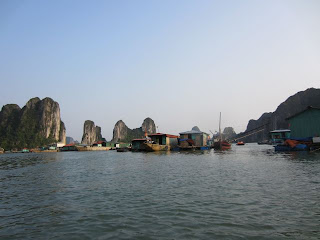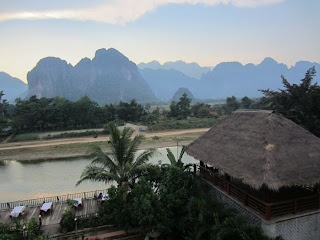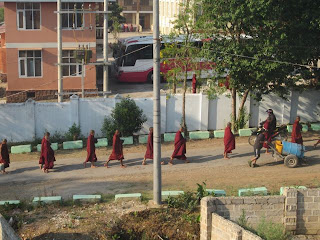Yesterday we flew from Danang, Vietnam, to Siem Reap, Cambodia, after three days in Hoian. Cua Dai Beach in Hoian was a welcome respite after the craziness of Hanoi. We spent a day of R&R enjoying the sun, white sand and warm, gentle waters of the South China Sea. We rode around on a scooter for the day, Pierre braving the crazy drivers here who dart around, using their horn as a signal. Once we got used to it, it was a good way to get about in this heat. The rest of our time there was spent visiting the old city on foot, enjoying the history of this port, and then a day biking in the countryside around rice paddies, fishing villages and shrimp farms, learning about life in the country.
We are really on the last leg of this long trip and beginning to pine for home. However we may have kept the best for last.
It is hard to believe that we can now visit Cambodia less than thirty years since the civil war and POL POT's regime of the Khmer Rouge destroyed the country, killing over 25% of the population. Today Cambodia is trying to put those terrible years behind it and to move on as it restores its infrastructures after years of war. There is still corruption and poverty, easily visible in the city and surrounding area by the number of children and many handicapped people selling trinkets at the Angkor sites. But we are told that things are improving. This warm, gentle people want a better lives for themselves and their families.
Much of the rebuilding has occurred with the help of NGOs that are a fixture here now. Tourism has increased in the last twenty years making it a major resource in the country. Siem Reap, about four hours north of Phnom Penh by bus, has undergone a building boom, new hotels springing up to deal with the number of tourists who flock here to visit the temples of Angkor.
Grand Bayon temple
We have spent the last three days temple hopping, starting with sunset over Angkor as seen from
Phnom Bakheng. Because I was wearing a sleeveless blouse I was not allowed to climb to the top so I could only see the view of Angkor through Pierre's eyes and camera. We had better luck on our second attempt. We spent six hours, starting at 5am, visiting several sites with the help of our tuk-tuk driver. The temperature is about 38 degrees Celsius and it becomes unbearable after a while. Dreams of ice cold water and a swimming pool brought us back to the hotel by noon.
View of Angkor Wat from Phnom Bakheng
These sites are spectacular as they rise from the forest around them. We are reminded of visiting Tikal, Guatamala in 1974, when it was first opening to the public after many years of being hidden in the jungle. Some of the ruins at the Angkor site are covered with plants. The roots of trees wind around many of the old structures. There are piles of stones that have been numbered and are awaiting placement in their rightful position as archeologists reconstruct temples that were built, some over 1000 years ago. There is a sense of awe at the spirituality that surrounds these temples. Many thousands of people built them and spent their lives here, governed by the kings who had the temples built in celebration of their beliefs and their own greatness.
Pierre's reaction when we entered the first of several temples was that he was reminded of Indiana Jones as he searched for lost treasure. Sure enough, our tour guide confirmed that not only were we walking in the steps of Harrison Ford, but also those of Angelina Jolie in Tomb Raider and Marlon Brando in Apocalypse Now. These temples have had some illustrious visitors over the years.
Climbing to the upper levels of some buildings gives a great view and allows one to see arches, doors and murals at the upper levels. But the stairs up are treacherous, with narrow steps that are worn down with use over time. Even in places where they have built wooden steps up it is a steep climb and in some places we declined the opportunity to get to the top. In fact, we were not too disappointed to be refused entry to the upper levels at Angkor Wat because those steps only open at 8am. I am not sure that once I got up there I would have wanted to come down!
Descent from the heights, clinging to the sides in fear
For our third visit we hired a guide as well as our tuk-tuk driver. What a privilege it was to hear the stories about these sites. Having a guide also brought us to temples that are not as crowded with tourists and allowed us to know the best times to avoid the crowds. We feel much better informed about the development of this huge area of temples and the religious beliefs that motivated their construction.
Tree roots taking over the ruins at Ta Prohm
The lady's temple (Bantay Srei)
On our return back to Siem Reap we stopped at the Land Mines Museum and orphanage. This added a sobering reality to our trip here. The testimonies of ordinary people whose lives have been changed as they continue to farm areas where unexploded mines remain, break my heart. Reading their stories and seeing the art work that depicts their experience was very moving. This enterprise is run by a former member of the Khmer Rouge recruited as a child, but who now works at de-mining his country and supporting victims of the land mines. It was heart-warming to learn that a Canadian NGO is supporting the de-mining operations in Cambodia. To add a personal touch to this, our guide, who at age 33 lived during the civil war, showed us a bullet wound on his leg resulting from being shot at while working in his family's rice field. How fortunate we are to live in a country such as Canada where we have known only peace for over 70 years. This thought will be carried home when we return in 3 days. May it last forever.
We are really on the last leg of this long trip and beginning to pine for home. However we may have kept the best for last.
It is hard to believe that we can now visit Cambodia less than thirty years since the civil war and POL POT's regime of the Khmer Rouge destroyed the country, killing over 25% of the population. Today Cambodia is trying to put those terrible years behind it and to move on as it restores its infrastructures after years of war. There is still corruption and poverty, easily visible in the city and surrounding area by the number of children and many handicapped people selling trinkets at the Angkor sites. But we are told that things are improving. This warm, gentle people want a better lives for themselves and their families.
Much of the rebuilding has occurred with the help of NGOs that are a fixture here now. Tourism has increased in the last twenty years making it a major resource in the country. Siem Reap, about four hours north of Phnom Penh by bus, has undergone a building boom, new hotels springing up to deal with the number of tourists who flock here to visit the temples of Angkor.
Grand Bayon temple
We have spent the last three days temple hopping, starting with sunset over Angkor as seen from
Phnom Bakheng. Because I was wearing a sleeveless blouse I was not allowed to climb to the top so I could only see the view of Angkor through Pierre's eyes and camera. We had better luck on our second attempt. We spent six hours, starting at 5am, visiting several sites with the help of our tuk-tuk driver. The temperature is about 38 degrees Celsius and it becomes unbearable after a while. Dreams of ice cold water and a swimming pool brought us back to the hotel by noon.
View of Angkor Wat from Phnom Bakheng
These sites are spectacular as they rise from the forest around them. We are reminded of visiting Tikal, Guatamala in 1974, when it was first opening to the public after many years of being hidden in the jungle. Some of the ruins at the Angkor site are covered with plants. The roots of trees wind around many of the old structures. There are piles of stones that have been numbered and are awaiting placement in their rightful position as archeologists reconstruct temples that were built, some over 1000 years ago. There is a sense of awe at the spirituality that surrounds these temples. Many thousands of people built them and spent their lives here, governed by the kings who had the temples built in celebration of their beliefs and their own greatness.
Pierre's reaction when we entered the first of several temples was that he was reminded of Indiana Jones as he searched for lost treasure. Sure enough, our tour guide confirmed that not only were we walking in the steps of Harrison Ford, but also those of Angelina Jolie in Tomb Raider and Marlon Brando in Apocalypse Now. These temples have had some illustrious visitors over the years.
Climbing to the upper levels of some buildings gives a great view and allows one to see arches, doors and murals at the upper levels. But the stairs up are treacherous, with narrow steps that are worn down with use over time. Even in places where they have built wooden steps up it is a steep climb and in some places we declined the opportunity to get to the top. In fact, we were not too disappointed to be refused entry to the upper levels at Angkor Wat because those steps only open at 8am. I am not sure that once I got up there I would have wanted to come down!
Descent from the heights, clinging to the sides in fear
For our third visit we hired a guide as well as our tuk-tuk driver. What a privilege it was to hear the stories about these sites. Having a guide also brought us to temples that are not as crowded with tourists and allowed us to know the best times to avoid the crowds. We feel much better informed about the development of this huge area of temples and the religious beliefs that motivated their construction.
Tree roots taking over the ruins at Ta Prohm
The lady's temple (Bantay Srei)
On our return back to Siem Reap we stopped at the Land Mines Museum and orphanage. This added a sobering reality to our trip here. The testimonies of ordinary people whose lives have been changed as they continue to farm areas where unexploded mines remain, break my heart. Reading their stories and seeing the art work that depicts their experience was very moving. This enterprise is run by a former member of the Khmer Rouge recruited as a child, but who now works at de-mining his country and supporting victims of the land mines. It was heart-warming to learn that a Canadian NGO is supporting the de-mining operations in Cambodia. To add a personal touch to this, our guide, who at age 33 lived during the civil war, showed us a bullet wound on his leg resulting from being shot at while working in his family's rice field. How fortunate we are to live in a country such as Canada where we have known only peace for over 70 years. This thought will be carried home when we return in 3 days. May it last forever.














































